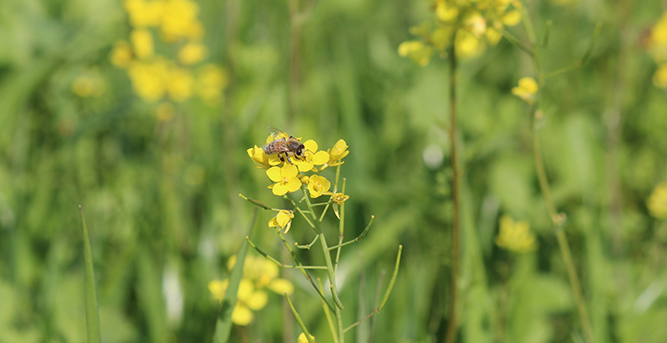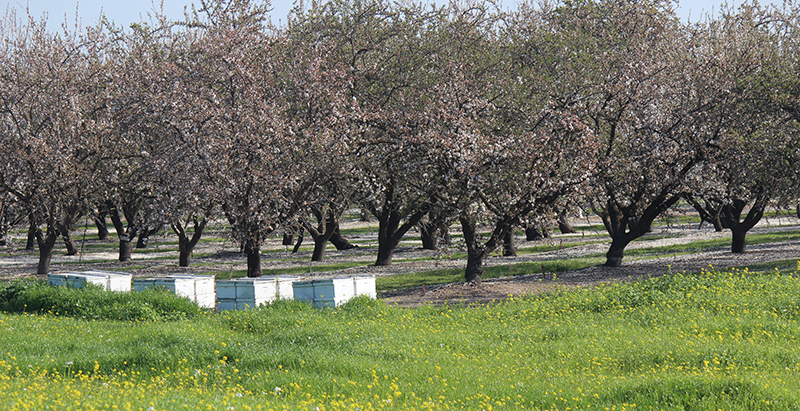By the time petals fall from almond blossoms, the nectar and pollen that honey bees collect and spread from flower to flower to pollinate the crop are gone. So as the almond bloom draws to a close, beekeepers arrive to remove their hives from the orchards, often moving their bees to pollinate other crops. But in the meantime, honey bees look outside of almond orchards for alternate food sources.
 Bee-friendly flowering plants, like this flowering mustard, provide a great source of food for honey bees when the almond trees have nothing left to give.
Bee-friendly flowering plants, like this flowering mustard, provide a great source of food for honey bees when the almond trees have nothing left to give.
At Lakeview Ranch they don’t have to go far. That’s because almond grower Jeff McPhee thoughtfully planted a field of bee-friendly flowering plants last fall, as he does every year, knowing it would provide a great source of food for honey bees when the almond trees have nothing left to give. McPhee grows 400 acres of almonds with his partner, Matt Friedrich, in Stanislaus County, Calif., where almonds are the No. 1 crop.
This year’s bee pasture at Lakeview Ranch is a mixture of mustard species. Mustards are among the many plants that provide excellent food for bees. Other popular plants are vetch, clover and legumes, such as beans, and each blooms at a different time of the year, providing an extended season when bees have ample and nutritious food.
More than 150 almond farmers have planted 3,000 acres of alternate honey bee food sources because they know they are good for the bees, and what’s good for the bees is good for the pollination of the almond crop, year after year.
Bee pastures also are good for beekeepers who bring in thousands of hives every year for the largest managed pollination event on Earth. When bees have a nutritious and plentiful source of food after almond blossoms are spent, beekeepers can leave hives in the orchards and continue to build bee strength until it is time to move on to their next pollination gig, which could be for cherries, oranges, melons, or one of many other crops that rely on managed honey bees for pollination.
 More than 150 almond farmers have planted thousands of acres of flowering plants because they are good for the bees.
More than 150 almond farmers have planted thousands of acres of flowering plants because they are good for the bees.
Lakeview Ranch’s bee pastures are also feeding wild bees that find their way onto the property, supplementing nature’s offerings and helping to secure the health of wild bee populations. The bee pastures are so successful at providing an alternate food source that McPhee has reached out to properties around Woodward Lake to increase their habitat.
When the mustard dries up as summer approaches, McPhee mows and tills the pasture, improving the health of the soil by adding a natural source of nitrogen and organic matter. “Every year we see the benefit of improved soil health with bigger and stronger flowering plants for the bees,” he says. “And rather than let the pastures idle in the summer, we plant either sunflowers or pumpkins, which our kids and their friends love.”
Seed for bee pastures is provided at no cost from the nonprofit organization Project Apis m. The name comes from the scientific nomenclature for honey bees — Apis mellifera. Project Apis m.’s mission is to fund and direct research to enhance the health and vitality of honey bee colonies while improving crop production. Project Apis m. has developed seed mixes to provide floral diversity prior to and after almond bloom in California for the nearly 1.8 million colonies that are brought to almond orchards for pollination. Just like humans, honey bees are best able to deal with stress issues when they get ongoing nourishment after the vital almond bloom.
And if they are lucky enough to be brought to a place like Lakeview Ranch, they can feed first among the almond blossoms, and then in the bee pasture before it’s time to move on.